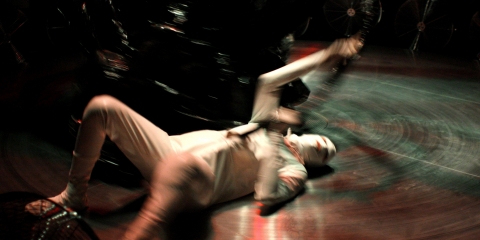VORTEX
VORTEX
Statement of Intent
Beneath how many layers do we hide our true selves , in order to tailor our « public » appearance ?
Who dares proclaim their « abnormality » ?
Which part of us is lying dormant, hidden away, either in the surface layers or in the depth of our being?
How can we escape the grip of artifice in order to show who we really are ?
I want to throw off the shackles, brave the different transformations – the « sloughed skins » – to try and touch upon the freedom of being. Fight against a moral code fuelled by fear and stigmatisation. Perceive the abnormal as something other than pain and suffering.
In the arena of « VORTEX », the norm does not exist, or else it is deliberately false in order to widen our perception of the need to extract ourselves from taboos. Here, the wind is oscillating matter used to escape gravity and awaken « The Alien » ; the part of us in hiding, heavily disguised beneath a borrowed uniform.
Phia Ménard (with the kind help of Anne Quentin)
October 2011
Cast
VORTEX
Performed by Phia Ménard
Dramaturgy assistant: Jean-Luc Beaujault
Creation team
Artistic direction, choreography and scenography: Phia Ménard
Soundtrack composition: Ivan Roussel using Claude Debussy’s music
Lighting design: Alice Rüest
Wind design: Pierre Blanchet
Scenography design: Phia Ménard
Set construction: Philippe Ragot assisted by Rodolphe Thibaud and Samuel Danilo
Sound master alternately: Ivan Roussel and Olivier Gicquiaud
Lighting technician alternately: Aurore Baudouin and Olivier Tessier
Stage manager and wind manager: Manuel Menes
Costumes and accessories: Fabrice Ilia Leroy
Dressmaker alternately: Fabrice Ilia Leroy and Yolene Guais
Tour manager: Pierre Blanchet
Photographs: Jean-Luc Beaujault
Production, administration: Claire Massonnet
Production and administration assistant: Constance Winckler
Public relations: Justine Lasserrade
Featuring the manipulation of objects and elements – Plays of Wind
VORTEX – Length: 50 minutes – Suitable for adults
Coproductions and residencies with La Comédie de Caen, centre dramatique national de normandie (National Dramatic Centre of Normandy), and with « La Brèche » – (Circus Arts Center for Basse-Normandie) in Cherbourg. Coproduction with « Le Quai » in Angers (« EPCC-Le Quai, Angers et le réseau européen IMAGINE 2020 – Art et Changement Climatique »), with the multi-sited structure « Scènes du Jura » (« Jura Scenes »), with « La Halle aux Grains » – the national theatre of Blois, with the Jules Verne Circus – Regional Centre for Circus Arts in Amiens, with « le Grand T » the Loire-Atlantique subsidised performance space in Nantes, with the Théâtre Universitaire of Nantes, with « l’Arc » the subsidised performance space of Rezé, with Parc de la Villette in Paris, and with « La Verrerie » in Alès in the Cévennes/Pôle National des Arts du Cirque (National Center for Circus Arts) in Languedoc-Roussillon. Residency with « Les Subsistances » 2010/2011, in Lyon, France.
With the support of the Théâtre de Thouars, a subsidised performance space in collaboration with the Cultural Services of Montreuil-Bellay, with « le Grand R » national theatre of La Roche-sur-Yon and with « Le Fanal », national theatre of Saint-Nazaire.
The Compagnie Non Nova – Phia Ménard is subsidised by the French Ministry of Culture and Communication – DRAC des Pays de la Loire, Nantes City Council, the Conseil Régional des Pays de la Loire and the Conseil Départemental de Loire-Atlantique. The company also receives support from the Institut Français (France’s international cultural relations body) and the BNP Paribas Foundation.
The company is based in Nantes.
The Compagnie Non Nova – Phia Ménard is currently associate artist at Malraux scène nationale Chambery Savoie, and the « TNB, Centre Européen Théâtral et Chorégraphique de Rennes » (National Theatre of Brittany).
Warm thanks to Pierre OREFICE, to the teachers and pupils of Gaston Serpette School in Nantes (the nursery classes and the youngest class in the primary section 2008/2009), to Pierre WATELET and Mathilde CARTON from the Natural History Museum of Nantes and to Pascal LEROUX from Collectif la Valise in Nantes
Photos
Vidéo
THE VORTEX
In meteorology, when talking about tornados and cyclones, we use the term vortex to designate an atmospheric, whirling circulation (specific to a depression), materialised by the inward curling of one or many cloud waves, spiralling around a center of rotation. It is therefore a zone of low pressure, also known as « the eye of the cyclone ».
VORTEX
A FIGHT FOR LIFE
In Vortex there is this double game : I am playing with the wind which in turn is playing with me. I am playing at war with it, yet at the same time there is a real war going on between us. There is a troubling, ambiguous relationship between this devouring, fascinating element – the wind – and the desire to die. Vortex presents us with a series of transformations, which are brought about through struggle. A fight to the death ? A struggle for survival ?
Yes, there is a lot of struggling. But isn’t living all about struggling? Isn’t each combat an attempt to be reborn, or the hope to be reborn? And even if each battle is in vain, just the Utopic belief that we can tame the wind keeps us fighting, keeps us alive. But there is nothing heroic about incessantly trying to undo oneself. Transformation obliges us to go through a series of states, from courage to cowardice, from war to abandon, from acceptance to rejection. The essential question is : what is left ? What do we do with all these things which surround us, enclose us, pollute us ? In VORTEX, everything is physical matter, except for the character at the beginning. He is a suit-with-a-tie, a man hidden behind a white mask, the archetype of a social shell beneath which the individual is invisible. In trying to truly exist, he has to undo himself over and over again, return to an embryonic state, empty himself out to shed his skin. It’s a never-ending quest, but I come out of it alive !
The vortex is a wind. It is central in the performance space. Aside from the fact that it is an element which is ephemeral, unstable, what have you and your team discovered through manipulating it ?
Over the past three years we have been testing the wind in a pragmatic way, using experiements that resemble craft projects more than scientific research. Just like ice, the wind is an unstable element. The wind makes people uneasy, tense, jumpy. It is cold, we have soon had enough of it. It requires us – we humans – to adapt to it, rather than it adapting to us. In this sense, it obliges us to let go, to give up trying to control everything, « to throw caution to the wind ». It does things, changes things, all on its own, and often the effect is beautiful… In the show we have to give it space, let it breath, yet without totally giving it free rein and risking losing the thread of the piece. Whatever we do, it never responds in exactly the same manner to the pertubations we inflict upon it. Of course, we know how to tame some of its effects, but only approximately. It is impossible to make it yield in any sort of precise manner to our will. And yet we cannot deviate from what we have decided works well technically. We have to be rigourous when working with it. We could play about with it far more, we could provoke all sorts of spectacular effects, but this isn’t our aim ; it would not make sense to the project and would merely be self-indulgent. But in the end, even when observing it, even when taming it, the wind remains a mystery. At each instant it can take the show in a new, unexpected direction. It is our theatre, it is the set we have chosen for our show, a set which remains invisible …
And then there is all this plastic ; omnipresent, polluting, suffocating …
Plastic evokes dustbins, trash cans, petrol, oil, consumerism, pollution … things which encumber and ultimately spoil our lives, but which take form in such banal, over-used forms, that we don’t even see them anymore. Plastic is so present in our lives that it no longer seems artificial.
The stage conception is circular. Is it meant to remind us of an arena, a circus ring?
It is the vortex, this concentric whirlwind, which forced us to work in-the-round. But this constraint helped us to develop our imaginative scope. The individual is encircled by ventilators, a bit like being in a lions’ cage. The only way of advancing is by turning ; turning round and round and round. Even caged animals go crazy.
Before VORTEX, you created the piece P.P.P. (Position Parallèle au Plancher / Perillous Parallel Position), in which you juggled with balls of ice. Ice and wind are very extreme elements, as beautiful as they are brutal, as fascinating as they are alarming. They create life, they keep things alive, yet they can also lead to death… Is this what attracts you to them ?
I think I chose these two elements mainly because we are all familiar with them. What interests me is matter which is palpable, uncontrollable, transformable and therefore, alive. Ice and wind symbolise unstable states in permanent movement ; ice changes into water, the wind turns … I want to to experiment with human capabilities in the midst of them. The air makes us questions ouselves. I am not looking to impress people with exploits and feats of skill. Anyone could do what I am doing ; simply experimenting with my limits. But would anyone really want to imprison themselves beneath layers and layers like I do, encaged in the wind ? Also, I really wonder what « exploit » means nowadays, in a world where virtual experiences offer us adventures and sensations which are so much stronger ?
You are creating three pieces based on the wind : Vortex », V1 and Afternoon of a Foehn. Three methods of experimenting with air, which themselves form part of a bigger project entitled « I.C.E. : Injonglabilité Complémentaire des Eléments » (Complementary Unjugglability of the Elements). Is this because you want to leave conventional juggling behind ?
It seems to me that P.P.P. (Position Parallèle au Plancher / Perillous Parallel Position) was the turning point. I had spent 2O years juggling with objects, with balls, and then one day I felt very limited. The object had been worn out. I knew that juggling and juggling balls were very functional – they demand a high level of technique – but they cannot tell much of a story. In P.P.P. I took on ice, an ephemeral, dangerous matter, which melts, breaks, and burns. Impossible to master, it is the total opposite of juggling with objects, where everything can be calculated and controlled, including when you miss or drop a ball. In contemporary juggling routines, even failure is dramatised and made to look like part of the show. For me, deep down, juggling was just a spectacular exploit. I juggled while I was « on show », while I was a representation of myself. My appearance, my skin, my gender were not my own. The day I was able to affirm my difference, lay claim to a sex that was not the one biology had imposed upon me, all of a sudden juggling no longer made any sense. But my experience is still very useful to me. When faced with a flying object I now apprehend the space with a very broad vision. My years of juggling have taught me the trajectories of flying objects, yet the wind imposes new, different trajectories.
You call the three shows based on the wind, « performance-art installations ». Is this a way of twisting the conventional framework of artistic forms ?
The term « art installation » evokes visual art, inert art. Performance art involves putting a human being into play ; it is an art form that is live, random, impossible to reproduce. This duality interests me. It opens up horizons which categories such as dance, circus and theatre do not authorise. The artistic field I belong to is open to the imaginative world, it refuses to be categorised. It is about defending a point of view, in an artistic form. Why classify things when society already forces so many set categories on us, as if we can’t live without them ? This political position is coherent with the essence of our project : questioning identity, defending the right to be unconventional, abnormal … It is the substance fuelling our artistic direction : where predetermined identities are concerned we want to be left in peace. Let’s simply accept each human being as he or she is. Or even as he or she could be. Let’s accept their states of body …
… The states of body symbolised by the movements, the transformations in Vortex. Each shedding of skin seems paroxysmal. We see desire, fusion, struggle, violence … Eros against Thanatos ?
There is beauty, disgust, domination too. Violent sensations which remind us that we are alive. Violence is a part of us ; if we bury it, it will resurge stronger than ever. A better solution is to exorcise it. But the violence in Vortex is cathartic. It is no doubt also a revolt against the body, against the gender inflicted upon an individual. But I think it is almost unconscious. I know that I never censor any gesture, unless it contradicts the essence of the project. As for the rest … is Eros involved ? Without a doubt, but where ? And Thanatos ? Surely, everywhere …
Phia Ménard, artistic director and Jean-Luc Beaujault, dramatist
A conversation with Anne Quentin










